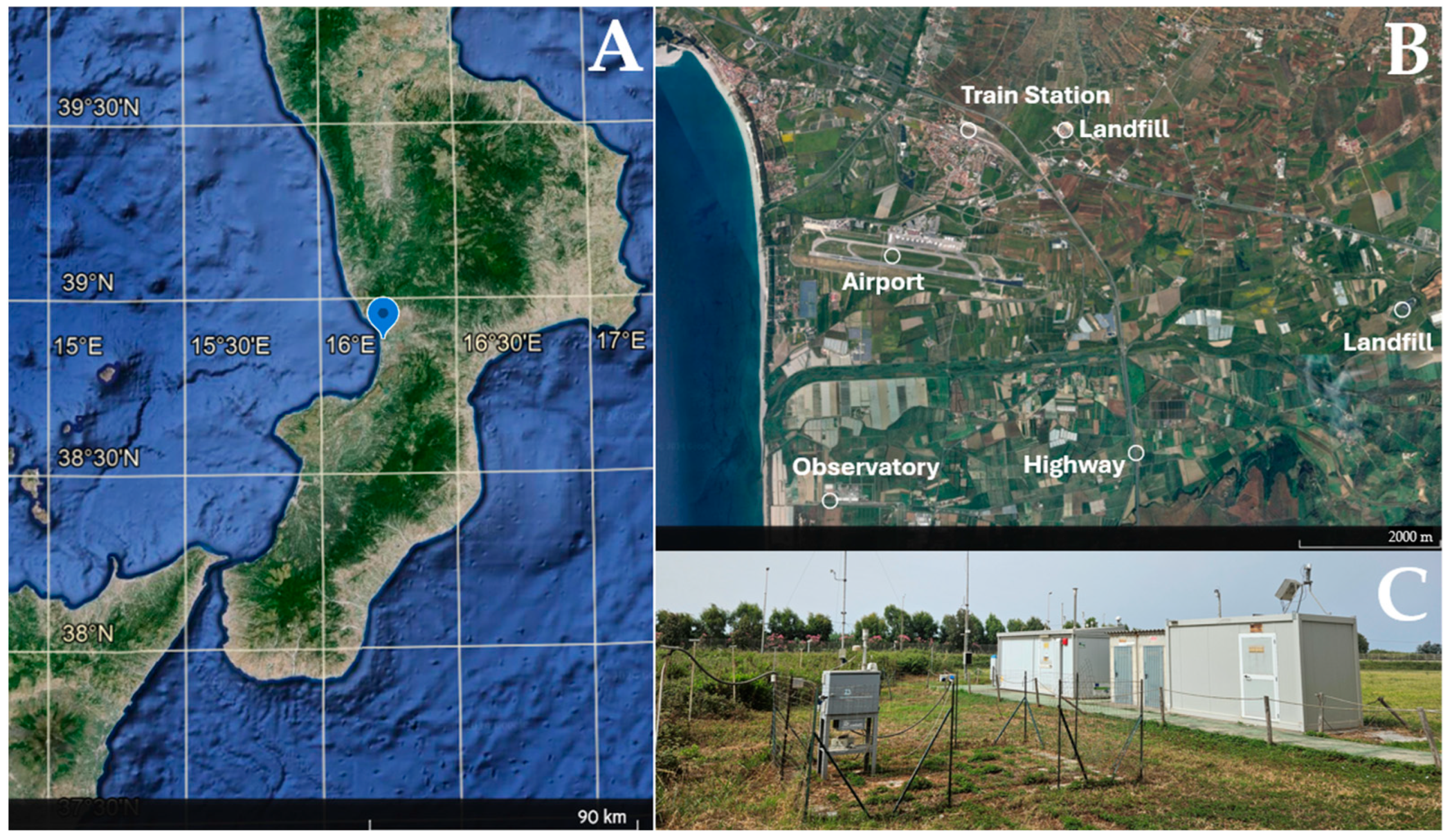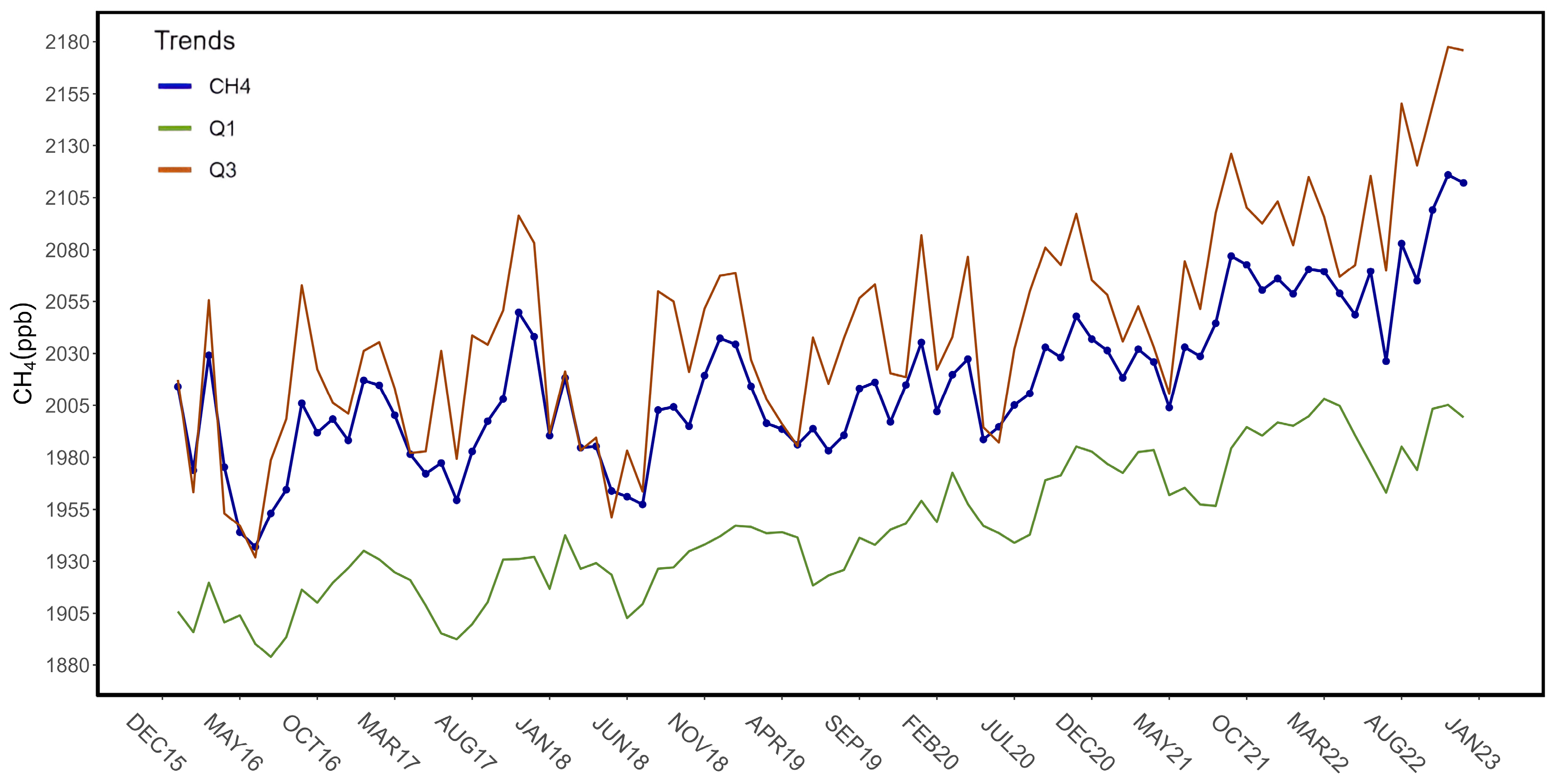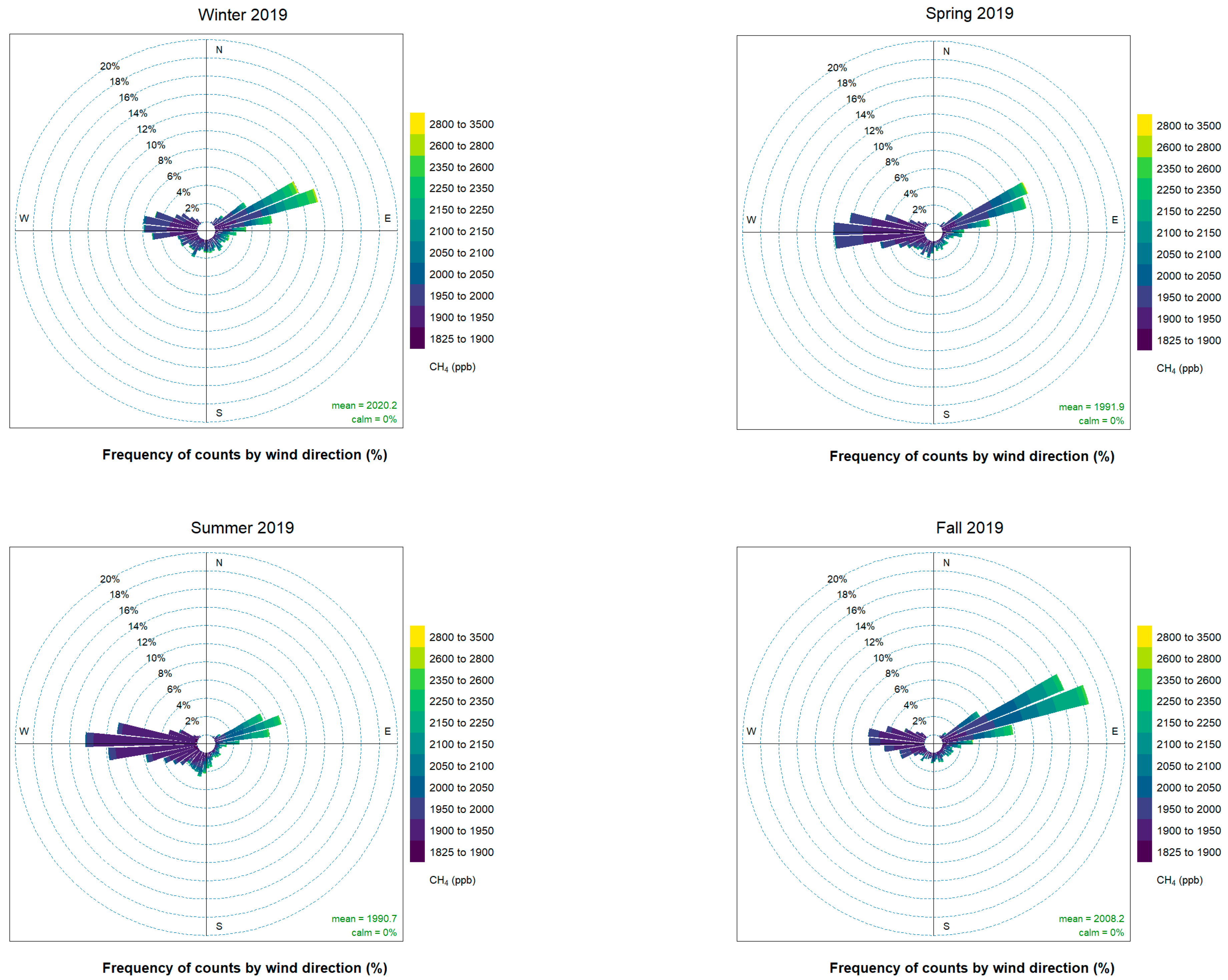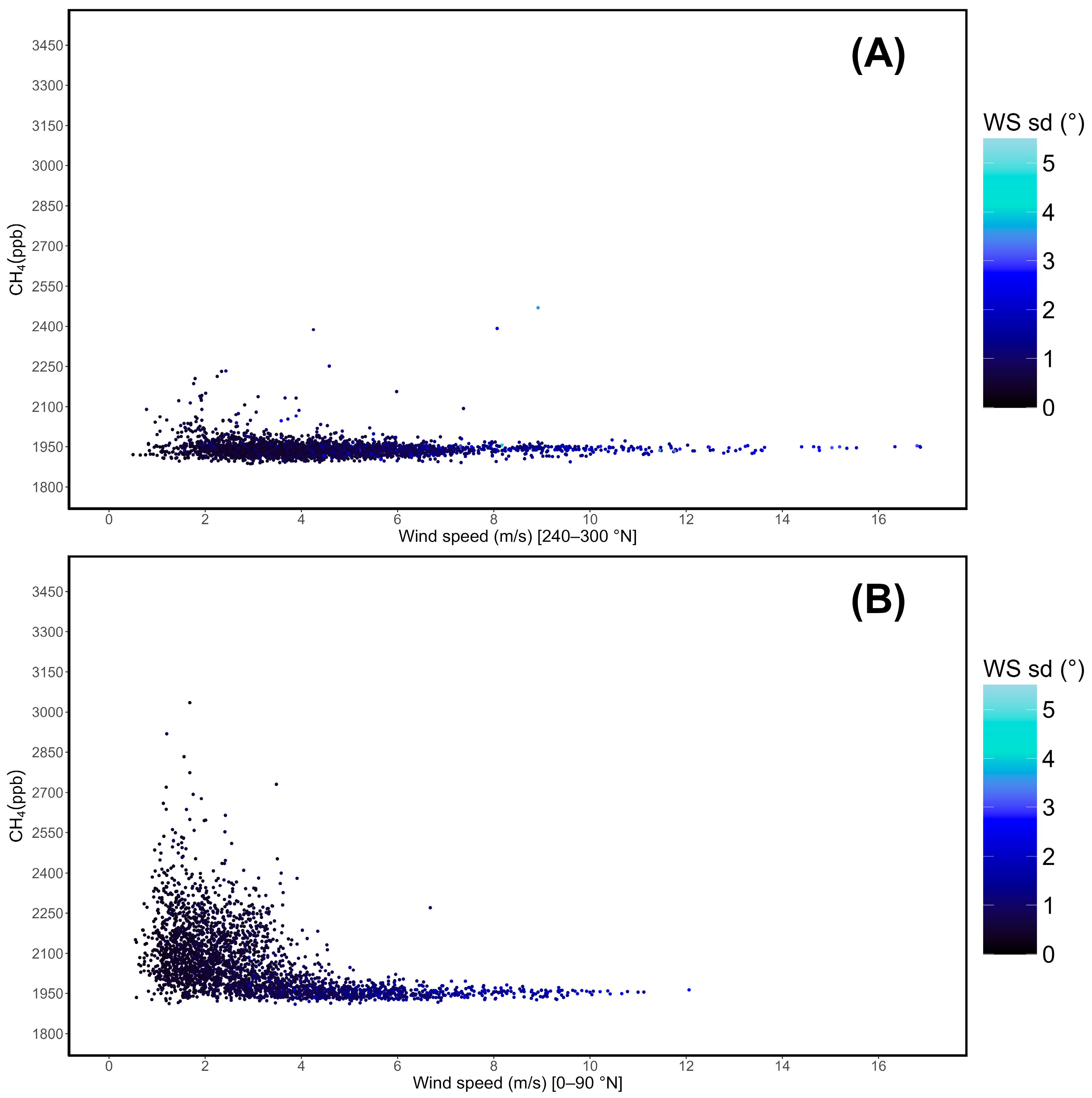Integrated Analysis of Methane Cycles and Trends at the WMO/GAW Station of Lamezia Terme (Calabria, Southern Italy)
Abstract
:1. Introduction
2. The Lamezia Terme CNR-ISAC Observatory
3. Instruments, Datasets, and Methods
4. Results
4.1. General Monthly Trend
4.2. Daily Cycle
4.3. Wind Data Evaluation
4.4. Outbreak Analysis
4.5. Multi-Year Trend
5. Discussion
6. Conclusions
Supplementary Materials
Author Contributions
Funding
Institutional Review Board Statement
Informed Consent Statement
Data Availability Statement
Acknowledgments
Conflicts of Interest
References
- Byrom, R.E.; Shine, K.P. Methane’s Solar Radiative Forcing. Geophys. Res. Lett. 2022, 49, e2022GL098270. [Google Scholar] [CrossRef]
- Myhre, G.; Shindell, D.; Bréon, F.M.; Collins, W.; Fuglestvedt, J.; Huang, J.; Koch, D.; Lamarque, J.F.; Lee, D.; Mendoza, B.; et al. Anthropogenic and Natural Radiative Forcing. In Climate Change 2013: The Physical Science Basis, Contribution of Working Group I to the Fifth Assessment Report of the Intergovernmental Panel on Climate Change; Intergovernmental Panel on Climate Change: Cambridge, UK; New York, NY, USA, 2013. [Google Scholar]
- Sand, M.; Skeie, R.B.; Sandstad, M.; Krishnan, S.; Myhre, G.; Bryant, H.; Derwent, R.; Hauglustaine, D.; Paulot, F.; Prather, M.; et al. A multi-model assessment of the Global Warming Potential of hydrogen. Nat. Commun. 2023, 4, 203. [Google Scholar] [CrossRef]
- Etheridge, D.M.; Steele, L.P.; Francey, R.J.; Langenfelds, R.L. Atmospheric methane between 1000 A.D. and present: Evidence of anthropogenic emissions and climatic variability. J. Geophys. Res. Atmos. 1998, 103, 15979–15993. [Google Scholar] [CrossRef]
- Nisbet, E.G.; Manning, M.R.; Dlugokencky, E.J.; Fisher, R.E.; Lowry, D.; Michel, S.E.; Lund Myhre, C.; Platt, S.M.; Allen, G.; Bousquet, P.; et al. Very Strong Atmospheric Methane Growth in the 4 Years 2014–2017: Implications for the Paris Agreement. Glob. Biogeochem. Cycles 2019, 33, 318–342. [Google Scholar] [CrossRef]
- Blunden, J.; Boyer, T.; Bartow-Gillies, E. State of the Climate in 2022. B. Am. Meteorol. Soc. 2023, 104, 1–501. [Google Scholar] [CrossRef]
- Skeie, R.B.; Hodnebrog, Ø.; Myhre, G. Trends in atmospheric methane concentrations since 1990 were driven and modified by anthropogenic emissions. Commun. Earth Environ. 2023, 4, 317. [Google Scholar] [CrossRef]
- Szopa, S.; Naik, V.; Adhikary, B.; Artaxo, P.; Berntsen, T.; Collins, W.D.; Fuzzi, S.; Gallardo, L.; Kiendler-Scharr, A.; Klimont, Z.; et al. Short-Lived Climate Forcers. In Climate Change 2021: The Physical Science Basis. Contribution of Working Group I to the Sixth Assessment Report of the Intergovernmental Panel on Climate Change; Masson-Delmotte, V., Zhai, P., Pirani, A., Connors, S.L., Péan, C., Berger, S., Caud, N., Chen, Y., Goldfarb, L., Gomis, M.I., et al., Eds.; Cambridge University Press: Cambridge, UK; New York, NY, USA, 2021; pp. 817–922. [Google Scholar]
- Dlugokencky, E.J.; Steele, L.P.; Lang, P.M.; Masarie, K.A. The growth rate and distribution of atmospheric methane. J. Geophys. Res. Atmos. 1994, 99, 17021–17043. [Google Scholar] [CrossRef]
- Saunois, M.; Bousquet, P.; Poulter, B.; Peregon, A.; Ciais, P.; Canadell, J.G.; Dlugokencky, E.J.; Etiope, G.; Bastviken, D.; Houweling, S.; et al. The global methane budget 2000–2012. Earth Syst. Sci. Data 2016, 8, 697–751. [Google Scholar] [CrossRef]
- Saunois, M.; Bousquet, P.; Poulter, B.; Peregon, A.; Ciais, P.; Canadell, J.G.; Dlugokencky, E.J.; Etiope, G.; Bastviken, D.; Houweling, S.; et al. Variability and quasi-decadal changes in the methane budget over the period 2000–2012. Atmos. Chem. Phys. 2017, 17, 11135–11161. [Google Scholar] [CrossRef]
- Saunois, M.; Stavert, A.R.; Poulter, B.; Bousquet, P.; Canadell, J.G.; Jackson, R.B.; Raymond, P.A.; Dlugokencky, E.J.; Houweling, S.; Patra, P.K.; et al. The Global Methane Budget 2000–2017. Earth Syst. Sci. Data 2020, 12, 1561–1623. [Google Scholar] [CrossRef]
- Montzka, S.A. The NOAA annual greenhouse gas index (AGGI). NOAA Glob. Monit. Lab. 2023. Available online: https://gml.noaa.gov/aggi/aggi.html (accessed on 16 July 2024).
- Lan, X.; Nisbet, E.G.; Dlugokencky, E.J.; Michel, S.E. What do we know about the global methane budget? Results from four decades of atmospheric CH4 observations and the way forward. Philos. Trans. A Math. Phys. Eng. Sci. 2021, 379, 20200440. [Google Scholar] [CrossRef] [PubMed]
- IEA Methane Tracker 2021. International Energy Agency, Paris, 2021. Available online: https://www.iea.org/reports/methane-tracker-2021 (accessed on 16 July 2024).
- Etiope, G.; Ciotoli, G.; Schwietzke, S.; Schoell, M. Gridded maps of geological methane emissions and their isotopic signature. Earth Syst. Sci. Data 2019, 11, 1–22. [Google Scholar] [CrossRef]
- Chang, J.; Peng, S.; Ciais, P.; Saunois, M.; Dangal, S.R.S.; Herrero, M.; Havlík, P.; Tian, H.; Bousquet, P. Revisiting enteric methane emissions from domestic ruminants and their δ13CCH4 source signature. Nat. Commun. 2019, 10, 3420. [Google Scholar] [CrossRef] [PubMed]
- Dlugokencky, E.; Nisbet, E.G.; Fisher, R.; Lowry, D. Global atmospheric methane: Budget, changes and dangers. Philos. Trans. A Math. Phys. Eng. Sci. 2011, 369, 2058–2072. [Google Scholar] [CrossRef] [PubMed]
- Blake, D.R.; Mayer, E.W.; Tyler, S.C.; Makide, Y.; Montague, D.C.; Rowland, F.S. Global increase in atmospheric methane concentrations between 1978 and 1980. Geophys. Res. Lett. 1982, 9, 477–480. [Google Scholar] [CrossRef]
- Yu, L.; Huang, Y.; Zhang, W.; Li, T.; Sun, W. Methane uptake in global forest and grassland soils from 1981 to 2010. Sci. Total Environ. 2017, 607–608, 1163–1172. [Google Scholar] [CrossRef] [PubMed]
- Pison, I.; Ringeval, B.; Bousquet, P.; Prigent, C.; Papa, F. Stable atmospheric methane in the 2000s: Key-role of emissions from natural wetlands. Atmos. Chem. Phys. 2013, 13, 11609–11623. [Google Scholar] [CrossRef]
- Dlugokencky, E.; Masarie, K.; Lang, P.; Tans, P.P. Continuing decline in the growth rate of the atmospheric methane burden. Nature 1998, 393, 447–450. [Google Scholar] [CrossRef]
- Dlugokencky, E.J.; Houweling, S.; Bruhwiler, L.; Masarie, K.A.; Lang, P.M.; Miller, J.B.; Tans, P.P. Atmospheric methane levels off: Temporary pause or a new steady-state? Geophys. Res. Lett. 2003, 30, 1992. [Google Scholar] [CrossRef]
- He, J.; Naik, V.; Horowitz, L.W.; Dlugokencky, E.; Thoning, K. Investigation of the global methane budget over 1980–2017 using GFDL-AM4.1. Atmos. Chem. Phys. 2020, 20, 805–827. [Google Scholar] [CrossRef]
- Ferretti, D.F.; Miller, J.B.; White, J.W.C.; Etheridge, D.M.; Lassey, K.R.; Lowe, D.C.; Macfarling Meure, C.M.; Dreier, M.F.; Trudinger, C.M.; Van Ommen, T.D.; et al. Unexpected changes to the global methane budget over the past 2000 years. Science 2005, 309, 1714–1717. [Google Scholar] [CrossRef] [PubMed]
- Peng, S.; Lin, X.; Thompson, R.L.; Xi, Y.; Liu, G.; Hauglustaine, D.; Lan, X.; Poulter, B.; Ramonet, M.; Saunois, M.; et al. Wetland emission and atmospheric sink changes explain methane growth in 2020. Nature 2022, 612, 477–482. [Google Scholar] [CrossRef]
- Wilson, C. Untangling variations in the global methane budget. Nat. Commun. 2023, 4, 318. [Google Scholar] [CrossRef]
- Padilla, R.; Adame, J.A.; Hidalgo, P.J.; Bolivar, J.P.; Yela, M. Short-term trend and temporal variations in atmospheric methane at an Atlantic coastal site in Southwestern Europe. Atmos. Environ. 2023, 333, 120665. [Google Scholar] [CrossRef]
- Federico, S.; Pasqualoni, L.; De Leo, L.; Bellecci, C. A study of the breeze circulation during summer and fall 2008 in Calabria, Italy. Atmos. Res. 2010, 97, 1–13. [Google Scholar] [CrossRef]
- Cristofanelli, P.; Busetto, M.; Calzolari, F.; Ammoscato, I.; Gullì, D.; Dinoi, A.; Calidonna, C.R.; Contini, D.; Sferlazzo, D.; Di Iorio, T.; et al. Investigation of reactive gases and methane variability in the coastal boundary layer of the central Mediterranean basin. Elem. Sci. Anth. 2017, 5, 12. [Google Scholar] [CrossRef]
- Federico, S.; Pasqualoni, L.; Sempreviva, A.M.; De Leo, L.; Avolio, E.; Calidonna, C.R.; Bellecci, C. The seasonal characteristics of the breeze circulation at a coastal Mediterranean site in South Italy. Adv. Sci. Res. 2010, 4, 47–56. [Google Scholar] [CrossRef]
- Gullì, D.; Avolio, E.; Calidonna, C.R.; Lo Feudo, T.; Torcasio, R.C.; Sempreviva, A.M. Two years of wind-lidar measurements at an Italian Mediterranean Coastal Site. In European Geosciences Union General Assembly 2017, EGU—Division Energy, Resources & Environment, ERE. Energy Procedia 2017, 125, 214–220. [Google Scholar] [CrossRef]
- Lo Feudo, T.; Calidonna, C.R.; Avolio, E.; Sempreviva, A.M. Study of the Vertical Structure of the Coastal Boundary Layer Integrating Surface Measurements and Ground-Based Remote Sensing. Sensors 2020, 20, 6516. [Google Scholar] [CrossRef]
- Malacaria, L.; Parise, D.; Lo Feudo, T.; Avolio, E.; Ammoscato, I.; Gullì, D.; Sinopoli, S.; Cristofanelli, P.; De Pino, M.; D’Amico, F.; et al. Multiparameter detection of summer open fire emissions: The case study of GAW regional observatory of Lamezia Terme (Southern Italy). Fire 2024, 7, 198. [Google Scholar] [CrossRef]
- Calidonna, C.R.; Avolio, E.; Gullì, D.; Ammoscato, I.; De Pino, M.; Donateo, A.; Lo Feudo, T. Five Years of Dust Episodes at the Southern Italy GAW Regional Coastal Mediterranean Observatory: Multisensors and Modeling Analysis. Atmosphere 2020, 11, 456. [Google Scholar] [CrossRef]
- Lan, X.; Thoning, K.W.; Dlugokencky, E.J. Trends in Globally-Averaged CH4, N2O, and SF6 Determined from NOAA Global Monitoring Laboratory Measurements. Version 2024-06, 2024. Available online: https://gml.noaa.gov/ccgg/trends_doi.html (accessed on 18 June 2024).
- Laughner, J.L.; Neu, J.L.; Schimel, D.; Wennberg, P.O.; Barsanti, K.; Bowman, K.W.; Chatterjee, A.; Croes, B.E.; Fitzmaurice, H.L.; Henze, D.K.; et al. Societal shifts due to COVID-19 reveal large-scale complexities and feedbacks between atmospheric chemistry and climate change. Proc. Natl. Acad. Sci. USA 2021, 118, e2109481118. [Google Scholar] [CrossRef] [PubMed]
- Donateo, A.; Lo Feudo, T.; Marinoni, A.; Calidonna, C.R.; Contini, D.; Bonasoni, P. Long-term observations of aerosol optical properties at three GAW regional sites in the Central Mediterranean. Atmos. Res. 2020, 241, 104976. [Google Scholar] [CrossRef]
- Grossi, G.; Goglio, P.; Vitali, A.; Williams, A.G. Livestock and climate change: Impact of livestock on climate and mitigation strategies. Anim. Front. 2019, 9, 69–76. [Google Scholar] [CrossRef]
- Tapio, I.; Snelling, T.J.; Strozzi, F.; Wallace, R.J. The ruminal microbiome associated with methane emissions from ruminant livestock. J. Anim. Sci. Biotechnol. 2017, 8, 7. [Google Scholar] [CrossRef]
- Hristov, A.N.; Oh, J.; Firkins, J.L.; Dijkstra, J.; Kebreab, E.; Waghorn, G.; Makkar, H.P.S.; Adesogan, A.T.; Yang, W.; Lee, C.; et al. Special topics—Mitigation of methane and nitrous oxide emissions from animal operations: I. A review of enteric methane mitigation options. J. Anim. Sci. 2013, 91, 5045–5069. [Google Scholar] [CrossRef] [PubMed]
- Carslaw, D.C.; Beevers, S.D.; Ropkins, K.; Bell, M.C. Detecting and quantifying aircraft and other on-airport contributions to ambient nitrogen oxides in the vicinity of a large international airport. Atmos. Environ. 2006, 40, 5424–5434. [Google Scholar] [CrossRef]
- Carslaw, D.C.; Beevers, S.D. Characterising and understanding emission sources using bivariate polar plots and k-means clustering. Environ. Model. Softw. 2013, 40, 325–329. [Google Scholar] [CrossRef]
- Lee, D.S.; Fahey, D.; Forster, P.M.; Newton, P.J.; Wit, R.C.N.; Lim, L.L.; Owen, B.; Sausen, R. Aviation and global climate change in the 21st century. Atmos. Environ. 2009, 43, 3520–3537. [Google Scholar] [CrossRef]
- Lee, D.S.; Fahey, D.W.; Skowron, A.; Allen, M.R.; Burkhardt, U.; Chen, Q.; Doherty, S.J.; Freeman, S.; Forster, P.M.; Fuglestvedt, J.; et al. The contribution of global aviation to anthropogenic climate forcing for 2000 to 2018. Atmos. Environ. 2021, 244, 117834. [Google Scholar] [CrossRef] [PubMed]
- Grobler, C.; Wolfe, P.J.; Dasadhikari, K.; Dedoussi, I.C.; Allroggen, F.; Speth, R.L.; Eastham, S.D.; Agarwal, A.; Staples, M.D.; Sabnis, J.; et al. Marginal climate and air quality costs of aviation emissions. Environ. Res. Lett. 2018, 14, 114031. [Google Scholar] [CrossRef]
- Quadros, F.D.A.; Snellen, M.; Dedoussi, I.C. Regional sensitivities of air quality and human health impacts to aviation emissions. Environ. Res. Lett. 2020, 15, 105013. [Google Scholar] [CrossRef]
- Barrett, S.R.H.; Britter, R.E.; Waitz, I.A. Global Mortality Attributable to Aircraft Cruise Emissions. Environ. Sci. 2010, 44, 7736–7742. [Google Scholar] [CrossRef] [PubMed]
- Yim, S.H.L.; Lee, G.L.; Lee, I.H.; Allroggen, F.; Ashok, A.; Caiazzo, F.; Eastham, S.D.; Malina, R.; Barrett, S.R.H. Global, regional and local health impacts of civil aviation emissions. Environ. Res. Lett. 2015, 10, 034001. [Google Scholar] [CrossRef]
- Wild, O.; Prather, M.J.; Akimoto, H. Indirect long-term global radiative cooling from NOx emissions. Geophys. Res. Lett. 2001, 28, 1719–1722. [Google Scholar] [CrossRef]
- Stevenson, D.S.; Doherty, R.M.; Sanderson, M.G.; Collins, W.J.; Johnson, C.E.; Derwent, R.G. Radiative forcing from aircraft NOx emissions: Mechanisms and seasonal dependence. J. Geophys. Res. Atmos. 2004, 109, D17307. [Google Scholar] [CrossRef]
- McNorton, J.; Bousserez, N.; Agustí-Panareda, A.; Balsamo, G.; Cantarello, L.; Engelen, R.; Huijnen, V.; Inness, A.; Kipling, Z.; Parrington, M.; et al. Quantification of methane emissions from hotspots and during COVID-19 using a global atmospheric inversion. Atmos. Chem. Phys. 2022, 22, 5961–5981. [Google Scholar] [CrossRef]
- Feng, L.; Palmer, P.I.; Parker, R.J.; Lunt, M.F.; Bösch, H. Methane emissions are predominantly responsible for record-breaking atmospheric methane growth rates in 2020 and 2021. Atmos. Chem. Phys. 2023, 23, 4863–4880. [Google Scholar] [CrossRef]
- Turner, A.J.; Fung, I.; Naik, V.; Horowitz, L.W.; Cohen, R. Modulation of hydroxyl variability by ENSO in the absence of external forcing. Proc. Natl. Acad. Sci. USA 2018, 115, 8931–8936. [Google Scholar] [CrossRef]
- Zhao, Y.; Saunois, M.; Bousquet, P.; Lin, X.; Berchet, A.; Hegglin, M.I.; Canadell, J.G.; Jackson, R.B.; Deushi, M.; Jöckel, P.; et al. On the role of trend and variability in the hydroxyl radical (OH) in the global methane budget. Atmos. Chem. Phys. 2020, 20, 13011–13022. [Google Scholar] [CrossRef]
- Nicely, J.M.; Canty, T.P.; Manyin, M.; Oman, L.D.; Salawitch, R.J.; Steenrod, S.D.; Strahan, S.E.; Strode, S.A. Changes in Global Tropospheric OH Expected as a Result of Climate Change Over the Last Several Decades. J. Geophys. Res. Atmos. 2018, 123, 10774–10795. [Google Scholar] [CrossRef]
- Bândă, N.; Krol, M.; van Noije, T.; van Weele, M.; Williams, J.E.; Le Sager, P.; Niemeier, U.; Thomason, L.; Röckmann, T. The effect of stratospheric sulfur from Mount Pinatubo on tropospheric oxidizing capacity and methane. J. Geophys. Res. Atmos. 2015, 120, 1202–1220. [Google Scholar] [CrossRef]
- Hossaini, R.; Chipperfield, M.P.; Saiz-Lopez, A.; Fernandez, R.; Monks, S.; Feng, W.; Brauer, P.; von Glasow, R. A global model of tropospheric chlorine chemistry: Organic versus inorganic sources and impact on methane oxidation. J. Geophys. Res. Atmos. 2016, 121, 14271–14297. [Google Scholar] [CrossRef]
- Gromov, S.; Brenninkmeijer, C.A.M.; Jöckel, P. A very limited role of tropospheric chlorine as a sink of the greenhouse gas methane. Atmos. Chem. Phys. 2018, 18, 9831–9843. [Google Scholar] [CrossRef]
- Saueressig, G.; Bergamaschi, P.; Crowley, J.N.; Fischer, H.; Harris, G.W. Carbon kinetic isotope effect in the reaction of CH4 with Cl atoms. J. Geophys. Res. Atmos. 1995, 22, 1225–1228. [Google Scholar] [CrossRef]
- Lan, X.; Nisbet, E.G.; Dlugokencky, E.J.; Michel, S.E. Improved Constraints on Global Methane Emissions and Sinks Using δ13C-CH4. J. Geophys. Res. Atmos. 2021, 35, e2021GB007000. [Google Scholar] [CrossRef]
- Le Mer, J.; Roger, P. Production, oxidation, emission and consumption of methane by soils: A review. Eur. J. Soil Biol. 2001, 37, 25–50. [Google Scholar] [CrossRef]
- Hanson, R.S.; Hanson, T.E. Methanotrophic bacteria. Microbiol. Rev. 1996, 60, 439–471. [Google Scholar] [CrossRef]
- Oh, Y.; Zhuang, Q.; Liu, L.; Welp, L.R.; Lau, M.C.Y.; Onstott, T.C.; Medvigy, D.; Bruhwiler, L.; Dlugokencky, E.J.; Hugelius, G.; et al. Reduced net methane emissions due to microbial methane oxidation in a warmer Arctic. Nat. Clim. Chang. 2020, 10, 317–321. [Google Scholar] [CrossRef]
- Goldman, M.B.; Groffman, P.M.; Pouyat, R.V.; McDonnell, M.J.; Pickett, S.T.A. CH4 uptake and N availability in forest soils along an urban to rural gradient. Soil Biol. Biochem. 1995, 27, 281–286. [Google Scholar] [CrossRef]
- Ni, X.; Groffman, P.M. Declines in methane uptake in forest soils. Proc. Natl. Acad. Sci. USA 2018, 115, 8587–8590. [Google Scholar] [CrossRef] [PubMed]










| Year | Picarro Coverage (%) | Picarro-Vaisala (%) |
|---|---|---|
| 2016 | 94.92% | 92.2% |
| 2017 | 99.57% | 93.37% |
| 2018 | 94% | 74.68% |
| 2019 | 97.6% | 97.57% |
| 2020 | 93.8% | 93.79% |
| 2021 | 97.71% | 97.46% |
| 2022 | 83.83% | 75.41% |
| 94.49% 1 | 89.07% 1 |
| Hours | Winter | Win. SD | Spring | Spr. SD | Summer | Sum. SD | Fall | Fa. SD |
|---|---|---|---|---|---|---|---|---|
| 0 | 2076.27 | 163.49 | 2030.78 | 99.30 | 2066.69 | 113.04 | 2043.76 | 86.57 |
| 1 | 2076.78 | 157.14 | 2036.03 | 110.72 | 2078.96 | 118.00 | 2065.42 | 138.91 |
| 2 | 2087.11 | 162.39 | 2054.75 | 136.81 | 2084.67 | 124.21 | 2069.45 | 107.13 |
| 3 | 2082.18 | 161.63 | 2057.92 | 152.80 | 2102.78 | 130.50 | 2078.47 | 116.90 |
| 4 | 2087.75 | 174.86 | 2054.98 | 154.43 | 2088.88 | 123.60 | 2091.81 | 141.44 |
| 5 | 2079.08 | 156.14 | 2070.65 | 150.94 | 2086.37 | 122.84 | 2100.68 | 143.55 |
| 6 | 2089.18 | 167.36 | 2043.86 | 115.58 | 2045.54 | 100.81 | 2080.75 | 121.62 |
| 7 | 2096.24 | 178.82 | 2002.39 | 91.74 | 1980.23 | 57.72 | 2058.33 | 105.30 |
| 8 | 2043.12 | 120.53 | 1966.65 | 48.25 | 1943.77 | 26.59 | 1997.36 | 57.00 |
| 9 | 1994.23 | 90.90 | 1953.08 | 24.33 | 1933.72 | 16.59 | 1961.31 | 34.57 |
| 10 | 1964.34 | 38.20 | 1948.24 | 15.71 | 1931.18 | 14.27 | 1950.67 | 25.13 |
| 11 | 1955.17 | 27.22 | 1947.67 | 15.55 | 1929.20 | 14.54 | 1945.88 | 27.87 |
| 12 | 1953.52 | 24.69 | 1947.42 | 15.17 | 1926.67 | 13.62 | 1943.12 | 19.89 |
| 13 | 1952.92 | 25.71 | 1945.74 | 13.58 | 1925.17 | 14.20 | 1941.48 | 17.17 |
| 14 | 1951.27 | 17.15 | 1944.92 | 13.12 | 1925.21 | 15.02 | 1940.85 | 17.86 |
| 15 | 1952.23 | 18.01 | 1946.33 | 14.14 | 1924.65 | 14.22 | 1941.62 | 16.52 |
| 16 | 1956.75 | 24.34 | 1946.45 | 15.31 | 1924.85 | 14.36 | 1945.54 | 21.89 |
| 17 | 1967.86 | 38.03 | 1947.92 | 16.32 | 1926.58 | 19.07 | 1961.88 | 45.35 |
| 18 | 1979.94 | 49.42 | 1951.55 | 19.72 | 1928.99 | 31.05 | 1985.03 | 71.06 |
| 19 | 1994.36 | 65.39 | 1970.26 | 41.22 | 1938.43 | 40.10 | 1994.08 | 62.93 |
| 20 | 2009.53 | 83.48 | 1985.83 | 60.23 | 1977.44 | 92.46 | 2006.87 | 76.47 |
| 21 | 2030.08 | 102.69 | 2003.80 | 80.21 | 2019.90 | 111.61 | 2022.63 | 82.51 |
| 22 | 2046.53 | 124.62 | 2024.07 | 94.40 | 2033.38 | 115.17 | 2024.07 | 85.05 |
| 23 | 2051.48 | 135.37 | 2023.57 | 87.10 | 2051.06 | 114.79 | 2042.95 | 95.66 |
| Year | 3rd Q. (ppb) | Hours ≥ 3rd Q. | Average Count Per Weekday (3rd Q.) | 97.5% Threshold (ppb) | Hours ≥ 97.5% Threshold | Average Count per Weekday (97.5%) |
|---|---|---|---|---|---|---|
| 2016 | 1994.2 | 2085 | 297.85 | 2418.76 | 209 | 29.85 |
| 2017 | 2031.23 | 2181 | 311.57 | 2401.73 | 219 | 31.28 |
| 2018 | 2017.44 | 2059 | 294.14 | 2346.05 | 206 | 29.42 |
| 2019 | 2029.11 | 2138 | 305.71 | 2299.91 | 214 | 30.57 |
| 2020 | 2056.46 | 2060 | 294.28 | 2278.84 | 206 | 29.42 |
| 2021 | 2069.5 | 2140 | 305.71 | 2337.82 | 214 | 30.57 |
| 2022 | 2117.58 | 1836 | 262.28 | 2432.91 | 184 | 26.28 |
| 14,499 1 | 2071.28 2 | 1452 1 | 207.42 2 |
| Type | Average | MON | TUE | WED | THU | FRI | SAT | SUN | χ2 | p-Value |
|---|---|---|---|---|---|---|---|---|---|---|
| 3rd Q. | 2071.28 | 1899 | 2024 | 2089 | 2163 | 2246 | 2082 | 1996 | 37.152 | 0.0001 |
| 97.5% th. | 207.42 | 181 | 179 | 210 | 201 | 251 | 207 | 223 | 17.817 | 0.0064 |
| Year | CH4 (ppb) | CH4 SD (ppb) | Coverage (%) | Change (ppb) | NOAA (ppb) | NOAA Change (ppb) | LMT-NOAA Diff. (ppb) |
|---|---|---|---|---|---|---|---|
| 2016 | 1980.87 | 146.78 | 94.92 | - | 1843.12 | +7.05 | 137.75 |
| 2017 | 1999.75 | 140.30 | 99.57 | +18.88 | 1849.67 | +6.89 | 150.08 |
| 2018 | 1994.88 | 121.38 | 94 | −4.87 | 1857.33 | +8.70 | 137.55 |
| 2019 | 2002.50 | 106.98 | 97.6 | +7.62 | 1866.58 | +9.67 | 135.92 |
| 2020 | 2018.79 | 96.20 | 93.8 | +16.29 | 1878.93 | +15.17 | 139.86 |
| 2021 | 2040.79 | 105.99 | 97.71 | +22.00 | 1895.28 | +17.91 | 145.51 |
| 2022 1 | 2074.87 | 126.87 | 83.83 | +34.07 | 1922.53 | +13.26 | 137.75 |
Disclaimer/Publisher’s Note: The statements, opinions and data contained in all publications are solely those of the individual author(s) and contributor(s) and not of MDPI and/or the editor(s). MDPI and/or the editor(s) disclaim responsibility for any injury to people or property resulting from any ideas, methods, instructions or products referred to in the content. |
© 2024 by the authors. Licensee MDPI, Basel, Switzerland. This article is an open access article distributed under the terms and conditions of the Creative Commons Attribution (CC BY) license (https://creativecommons.org/licenses/by/4.0/).
Share and Cite
D’Amico, F.; Ammoscato, I.; Gullì, D.; Avolio, E.; Lo Feudo, T.; De Pino, M.; Cristofanelli, P.; Malacaria, L.; Parise, D.; Sinopoli, S.; et al. Integrated Analysis of Methane Cycles and Trends at the WMO/GAW Station of Lamezia Terme (Calabria, Southern Italy). Atmosphere 2024, 15, 946. https://doi.org/10.3390/atmos15080946
D’Amico F, Ammoscato I, Gullì D, Avolio E, Lo Feudo T, De Pino M, Cristofanelli P, Malacaria L, Parise D, Sinopoli S, et al. Integrated Analysis of Methane Cycles and Trends at the WMO/GAW Station of Lamezia Terme (Calabria, Southern Italy). Atmosphere. 2024; 15(8):946. https://doi.org/10.3390/atmos15080946
Chicago/Turabian StyleD’Amico, Francesco, Ivano Ammoscato, Daniel Gullì, Elenio Avolio, Teresa Lo Feudo, Mariafrancesca De Pino, Paolo Cristofanelli, Luana Malacaria, Domenico Parise, Salvatore Sinopoli, and et al. 2024. "Integrated Analysis of Methane Cycles and Trends at the WMO/GAW Station of Lamezia Terme (Calabria, Southern Italy)" Atmosphere 15, no. 8: 946. https://doi.org/10.3390/atmos15080946








